So who else picked this one up, and more importantly is familiar with this aircraft?
I would like to build Canadian ace Burden's mount, but have been reading it was one of the earlier Vipers with the Hispano engine and 4-blade prop? Also different engine cowl shape and no headrest.
There are several extra parts on the sprues, but does anyone know for certain if everything is there to build this early type?
Early Aviation
Discuss World War I and the early years of aviation thru 1934.
Discuss World War I and the early years of aviation thru 1934.
Hosted by Jim Starkweather
Eduard's 1/48 SE.5a

JackG

Joined: May 28, 2006
KitMaker: 172 posts
AeroScale: 26 posts

Posted: Wednesday, March 29, 2017 - 10:07 PM UTC

JackFlash

Joined: January 25, 2004
KitMaker: 11,669 posts
AeroScale: 11,011 posts

Posted: Wednesday, March 29, 2017 - 11:23 PM UTC
I have one in hand that I am working on for review. But here is a bit of fun on the subject.
https://www.facebook.com/search/top/?q=the%20shuttleworth%20collection
https://www.youtube.com/watch?v=PhdAm4RSB7s
https://www.facebook.com/search/top/?q=the%20shuttleworth%20collection
https://www.youtube.com/watch?v=PhdAm4RSB7s

JackG

Joined: May 28, 2006
KitMaker: 172 posts
AeroScale: 26 posts

Posted: Thursday, March 30, 2017 - 09:35 AM UTC
Thanks Stephen, I'll keep a lookout for your review and hope you touch on some of my questions there.
Posted: Thursday, March 30, 2017 - 01:44 PM UTC
Hi Jack
I'm keen to get stuck into the kit too, but it looks like there might be the parts you need among the spares.
There's a very interesting thread about Burden's aircraft over on The Aerodrome which might be a good help for you, especially the notes about the cowling.
Here's looking forward to seeing your build.
All the best
Rowan
I'm keen to get stuck into the kit too, but it looks like there might be the parts you need among the spares.
There's a very interesting thread about Burden's aircraft over on The Aerodrome which might be a good help for you, especially the notes about the cowling.
Here's looking forward to seeing your build.

All the best
Rowan


JackG

Joined: May 28, 2006
KitMaker: 172 posts
AeroScale: 26 posts

Posted: Thursday, March 30, 2017 - 09:04 PM UTC
Hi Rowan - thanks, yes Aerodrome is a great site for WW1 info. That particular thread you had linked is what brought to light the improper markings that Burden's aircraft is identified with.
It appears Eduard has used a post war modern build of Burden's aircraft rather than rely on an existing photo the pilot had sent home to his wife during the war.
It appears Eduard has used a post war modern build of Burden's aircraft rather than rely on an existing photo the pilot had sent home to his wife during the war.
Willard79

Joined: June 01, 2014
KitMaker: 189 posts
AeroScale: 179 posts

Posted: Friday, March 31, 2017 - 12:18 AM UTC
I'm not a bi-plane modeler, but I'd turn for this kit.
The SE5a features in Derek Robinson's Goshawk Squadron, which is great read IMO.
Maybe after I've reduced the stash a bit I'll indulge myself, in the mean time I'll happily follow any builds or reviews.
The SE5a features in Derek Robinson's Goshawk Squadron, which is great read IMO.
Maybe after I've reduced the stash a bit I'll indulge myself, in the mean time I'll happily follow any builds or reviews.

JackFlash

Joined: January 25, 2004
KitMaker: 11,669 posts
AeroScale: 11,011 posts

Posted: Saturday, April 01, 2017 - 04:18 AM UTC
Quoted Text
Thanks Stephen, I'll keep a lookout for your review and hope you touch on some of my questions there.
Greetings Jack, Just a note some of the questions you have on the SE 5a in general maybe found in other builds. I remember we had a good long discussion when I did the Roden 1/32 SE 5a. The differences in the Hisso and Viper versions and etc. Here is a list of good references.
“British Fighter Units 1917-18” by A. Revell, Osprey Pub. Ltd. 1978.
“Fighting Fifty Six” by A. Revell, Aeroplane Monthly Pp. 591 - 596, Nov. 1976
“S.E. 5 Fighter Supreme” by J.M. Bruce, Aeroplane Monthly Pp.264 - 269, May 1977
“S.E. 5 Fighter Supreme” by J.M. Bruce, Aeroplane Monthly Pp. 327 - 331, June 1977.
“S.E. 5 Fighter Supreme” by J.M. Bruce, Aeroplane Monthly Pp. 355 - 360, July 1977.
“S.E. 5 Fighter Supreme” by J.M. Bruce, Aeroplane Monthly Pp. 437 - 442, August 1977.
“S.E. 5 Fighter Supreme” by J.M. Bruce, Aeroplane Monthly Pp. 493 - 498, September 1977.
“S.E. 5 Fighter Supreme” by J.M. Bruce, Aeroplane Monthly Pp. 552 - 558, October 1977.
“S.E. 5 Fighter Supreme” by J.M. Bruce, Aeroplane Monthly Pp. 608 - 613, November 1977.
RAF SE 5a by J.M. Bruce, Datafile Special, Windsock pub.1993.
Royal Flying Corps in WWI by R. Rimell, Osprey Vintage Warbirds series #1, 1985.
The SE 5 by J.M. Bruce, Profile Publications #103, 1966.
The SE 5a by J. M. Bruce, Profile Publications #1, 1964.
Here is my old build with the discussions.
TVAL build
Willard79

Joined: June 01, 2014
KitMaker: 189 posts
AeroScale: 179 posts

Posted: Saturday, April 01, 2017 - 09:41 AM UTC
Thanks for posting this Stephen, it's a great resource and I didn't realize that TVAL is only 1.5hr drive north of me. The case for acquiring this kit keeps getting stronger.
Posted: Saturday, April 01, 2017 - 03:25 PM UTC
Hi again
Thanks for the reminder of your thread, Stephen. There are some really useful reference photos from Hugh Coleman in there, and that link to TVAL which David (67Foxtrot) sent us just makes me jealous of anyone like Spud who's lucky enough to live nearby! Just amazing!
You could also add Kagero's book (No. 6004) on the SE.5a to your list of refs, plus Windsock had some great inspiration for modelling American machines in a couple of issues a few years ago (Vol.29, Nos. 4 & 5).
All being well, Andy will be starting his "bare-bones" build this weekend, so I'll be pulling up a chair to see how it goes before taking the plunge myself.
All the best
Rowan
Thanks for the reminder of your thread, Stephen. There are some really useful reference photos from Hugh Coleman in there, and that link to TVAL which David (67Foxtrot) sent us just makes me jealous of anyone like Spud who's lucky enough to live nearby! Just amazing!

You could also add Kagero's book (No. 6004) on the SE.5a to your list of refs, plus Windsock had some great inspiration for modelling American machines in a couple of issues a few years ago (Vol.29, Nos. 4 & 5).
All being well, Andy will be starting his "bare-bones" build this weekend, so I'll be pulling up a chair to see how it goes before taking the plunge myself.

All the best
Rowan


JackG

Joined: May 28, 2006
KitMaker: 172 posts
AeroScale: 26 posts

Posted: Saturday, April 01, 2017 - 09:44 PM UTC
Hi Stephen, thank you for that extensive list of references. Having no regular source of income, I'm trying to avoid purchasing books, particularly when the subject is just a 'one-off' for me - no plans to build more than the lone SE.5a. Shelf space is another issue, but I digress...
I've found this diagram, which gives a good primer for the different cowl/engines types:

WingnutWings site also has some period photos, and combined with their build photos, can be handy:
http://www.wingnutwings.com/ww/product?productid=3
Main concern now is the specific markings for pilot Burden - need to find what exactly that St. Christopher medallion looked like.
I've found this diagram, which gives a good primer for the different cowl/engines types:

WingnutWings site also has some period photos, and combined with their build photos, can be handy:
http://www.wingnutwings.com/ww/product?productid=3
Main concern now is the specific markings for pilot Burden - need to find what exactly that St. Christopher medallion looked like.

JackG

Joined: May 28, 2006
KitMaker: 172 posts
AeroScale: 26 posts

Posted: Sunday, April 02, 2017 - 08:50 PM UTC
Right, so I've found an image of the photograph Burden annotated and sent home to his wife, which can be viewed here:
http://memorial.flight.free.fr/Burden.html
Judging by the pitch of the prop blades, it looks to be that of the Wolseley Viper engine, but the rad/cowl is still that of the Hispano - anyone else see it like this?
edit:
Well comparing to the previous image I put up of the three engine cowls, the Burden photo comparison indicates it is a Hispano engine and prop. So Eduard has got the wrong prop blade (part B10), for the Wolseley build?
http://memorial.flight.free.fr/Burden.html
Judging by the pitch of the prop blades, it looks to be that of the Wolseley Viper engine, but the rad/cowl is still that of the Hispano - anyone else see it like this?
edit:
Well comparing to the previous image I put up of the three engine cowls, the Burden photo comparison indicates it is a Hispano engine and prop. So Eduard has got the wrong prop blade (part B10), for the Wolseley build?

JackFlash

Joined: January 25, 2004
KitMaker: 11,669 posts
AeroScale: 11,011 posts

Posted: Monday, April 17, 2017 - 12:02 PM UTC
Greetings Jack,
In the references I provided Alex Revell notes that some early Viper powered SE 5a types has the Hispano-Suiza style nose and radiator. He dedicates a chapter on that and the choices of propellers. The low thrust angle of the engine spindle for the prop notes that it is an ungeared Viper motor.
Here is a bit of fun from my FB page on the subject of late model SE 5a aircraft.
In the references I provided Alex Revell notes that some early Viper powered SE 5a types has the Hispano-Suiza style nose and radiator. He dedicates a chapter on that and the choices of propellers. The low thrust angle of the engine spindle for the prop notes that it is an ungeared Viper motor.
Here is a bit of fun from my FB page on the subject of late model SE 5a aircraft.

JackG

Joined: May 28, 2006
KitMaker: 172 posts
AeroScale: 26 posts

Posted: Friday, April 21, 2017 - 10:25 AM UTC
Hi Stephen, thanks - and yes,after searching/reading some more at the Aerodrome forum, that does seem to be the case.
Now did all Viper engines spin in one direction - believe it was stated they were all geared, but not sure in which direction that translates to for the prop pitch ...
Now did all Viper engines spin in one direction - believe it was stated they were all geared, but not sure in which direction that translates to for the prop pitch ...

JackFlash

Joined: January 25, 2004
KitMaker: 11,669 posts
AeroScale: 11,011 posts

Posted: Friday, April 21, 2017 - 12:11 PM UTC
I'll try to help.
The kit includes an example of the Woseley W.4 Viper return to the "direct drive" (not geared) and the thrust line is lowered back to a center the fuselage. Noted for its 220hp the Wolseley became the late war standard. See below.
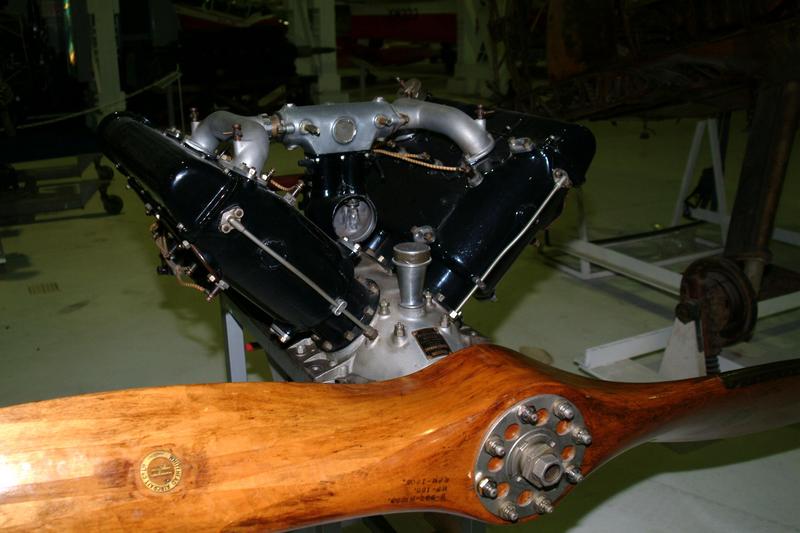
Just a note here. The Wolseley Viper 200hp and the Hispano - Suiza 200hp motors were manufactured by two different companies. The Wolseley Viper was a bit of a quirk in that it took the design characteristics of the direct drive Hispano Suiza 150hp and improved them. The original contract had implied the more powerful geared 200hp Hisso but Wolseley was supplied the direct drive 150hp as a technical reference.
The Hispano Suiza 200hp was geared and had the high location for the prop hub.

The kit includes an example of the Woseley W.4 Viper return to the "direct drive" (not geared) and the thrust line is lowered back to a center the fuselage. Noted for its 220hp the Wolseley became the late war standard. See below.

Just a note here. The Wolseley Viper 200hp and the Hispano - Suiza 200hp motors were manufactured by two different companies. The Wolseley Viper was a bit of a quirk in that it took the design characteristics of the direct drive Hispano Suiza 150hp and improved them. The original contract had implied the more powerful geared 200hp Hisso but Wolseley was supplied the direct drive 150hp as a technical reference.
The Hispano Suiza 200hp was geared and had the high location for the prop hub.


JackFlash

Joined: January 25, 2004
KitMaker: 11,669 posts
AeroScale: 11,011 posts

Posted: Friday, April 21, 2017 - 12:17 PM UTC
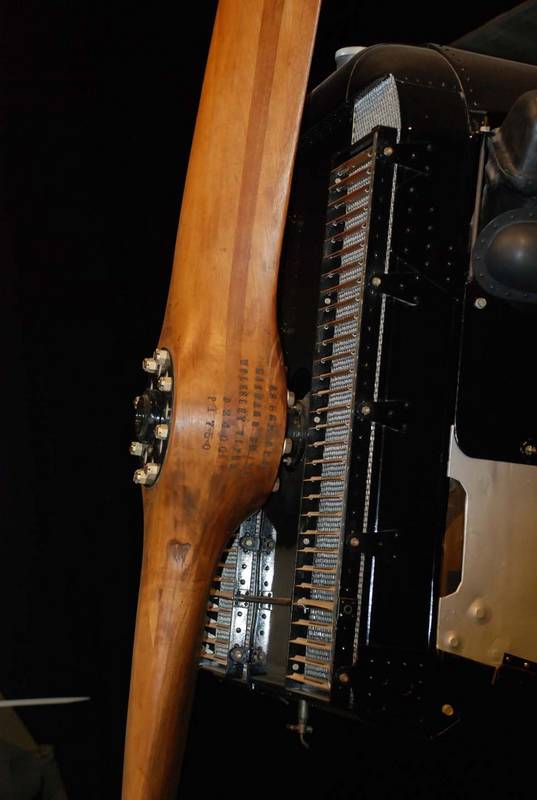
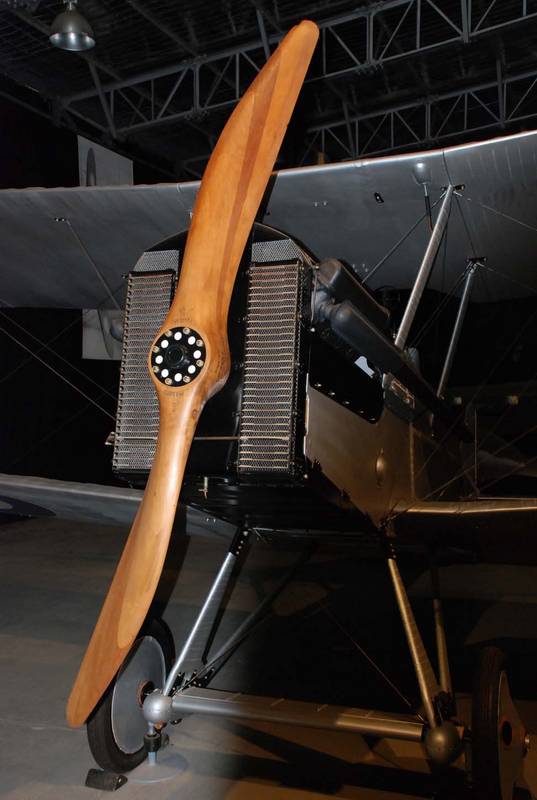
". . .The RAAF Museum at Point Cook, here in Melbourne. Point Cook is the longest continuous operating Airfield in the world, having been established in Feb 1914, and the Museum sports many examples of early aircraft operated by the Fledgling RAAF, Among which was the SE5a. . ." From my old friend MerlinV

JackFlash

Joined: January 25, 2004
KitMaker: 11,669 posts
AeroScale: 11,011 posts

Posted: Friday, April 21, 2017 - 12:23 PM UTC
Here is a quick visual reference from the items in the Roden 1/32 Viper kit. The first image may answer your question.
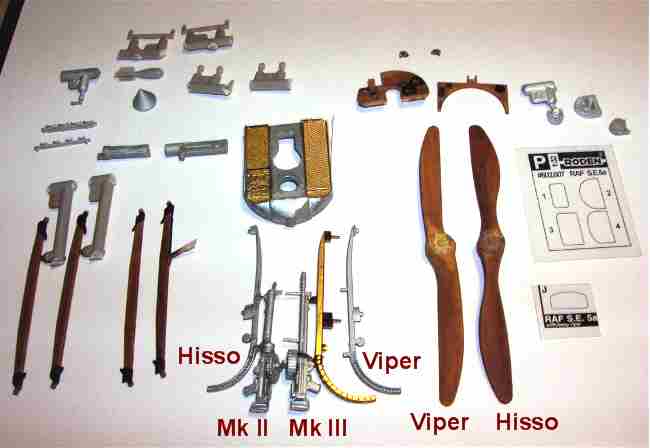
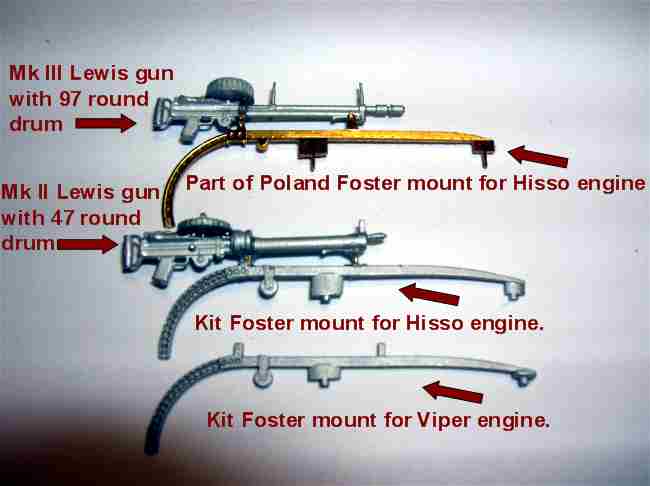
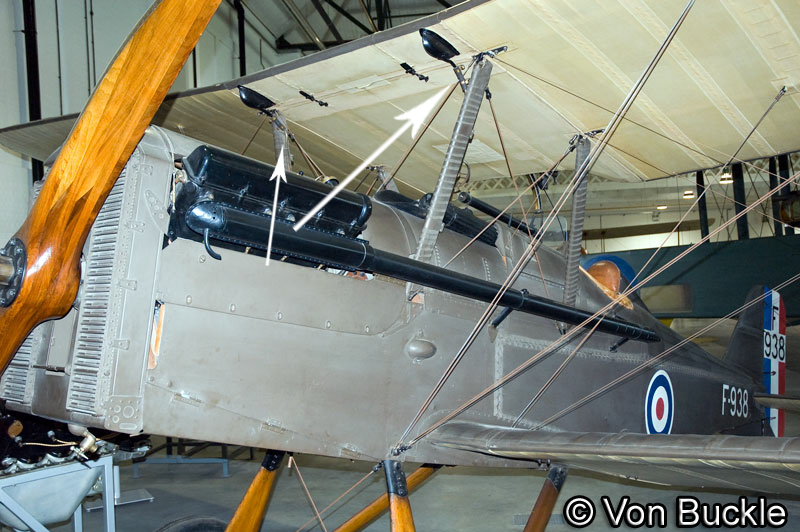
Note from the late Dan San Abbott. "The leading edge of the center-section was two tanks, the one on the left was auxiliary gravity fuel tank and the one on the right half was an radiator overflow expansion tank. Copper overflow lines ran from each tank to the trailing edge of the center section.
The plumbing from the bowl on the bottom of the auxiliary gravity tank went to the left front cabane strut and to the fuel selector cocks on the instrument board.
The radiator overflow plumbing ran from the radiator header to the right front cabane strut up the strut to the bowl on the bottom of the leading edge radiator expansion tank. An over flow copper lne ran from the top of the tank to the right trailing edge of the center-section.
All four cabane struts were steel tubes with leading and trailing wood fairings. The fairings were hollowed out fron and rear to reduce the weight. Holes were drilled in the top and bottom of the front fairing of the front cabane struts for the entry and exit of the copper plumbing. After the fairings were fixed the the strut tube, the strut was wrapped with a strip of linen fabric which was glued the wood fairings.



Note from the late Dan San Abbott. "The leading edge of the center-section was two tanks, the one on the left was auxiliary gravity fuel tank and the one on the right half was an radiator overflow expansion tank. Copper overflow lines ran from each tank to the trailing edge of the center section.
The plumbing from the bowl on the bottom of the auxiliary gravity tank went to the left front cabane strut and to the fuel selector cocks on the instrument board.
The radiator overflow plumbing ran from the radiator header to the right front cabane strut up the strut to the bowl on the bottom of the leading edge radiator expansion tank. An over flow copper lne ran from the top of the tank to the right trailing edge of the center-section.
All four cabane struts were steel tubes with leading and trailing wood fairings. The fairings were hollowed out fron and rear to reduce the weight. Holes were drilled in the top and bottom of the front fairing of the front cabane struts for the entry and exit of the copper plumbing. After the fairings were fixed the the strut tube, the strut was wrapped with a strip of linen fabric which was glued the wood fairings.

JackFlash

Joined: January 25, 2004
KitMaker: 11,669 posts
AeroScale: 11,011 posts

Posted: Friday, April 21, 2017 - 01:02 PM UTC
One final note the Squadron Signal SE 5a nose drawings were reversed when published. Here is how they should look. This is why people using this reference were having trouble. See your earlier post.



JackG

Joined: May 28, 2006
KitMaker: 172 posts
AeroScale: 26 posts

Posted: Friday, April 21, 2017 - 10:54 PM UTC
Excellent stuff there, Stephen - thanks a bunch!

JackFlash

Joined: January 25, 2004
KitMaker: 11,669 posts
AeroScale: 11,011 posts

Posted: Monday, May 08, 2017 - 06:45 PM UTC
Quoted Text
Excellent stuff there, Stephen - thanks a bunch!
I just finished the review. I'll send it along to Aeroscale in a day or two. But you can see it here.
MerlinV

Joined: November 26, 2006
KitMaker: 608 posts
AeroScale: 602 posts

Posted: Tuesday, May 09, 2017 - 06:34 AM UTC
Wow! Looks like my timing in raising my head above the parapet was almost perfect.
Strange to see my old images come to light again. How fortunate that I never deleted them from my old Flickr account.
Thanks for the credit on the FB page Stephen!
Cheers,
Hugh
Strange to see my old images come to light again. How fortunate that I never deleted them from my old Flickr account.
Thanks for the credit on the FB page Stephen!
Cheers,
Hugh

JackFlash

Joined: January 25, 2004
KitMaker: 11,669 posts
AeroScale: 11,011 posts

Posted: Tuesday, May 09, 2017 - 04:45 PM UTC
Quoted Text
Wow! Looks like my timing in raising my head above the parapet was almost perfect.
Strange to see my old images come to light again. How fortunate that I never deleted them from my old Flickr account.
Thanks for the credit on the FB page Stephen!
Cheers,
Hugh
You the man Hugh!

Scrodes

Joined: July 22, 2012
KitMaker: 771 posts
AeroScale: 763 posts

Posted: Tuesday, May 09, 2017 - 09:36 PM UTC
I don't know if this might be of interest, but this popped up the other day - making laminated propellers from paper!
https://www.facebook.com/groups/848474938507986/permalink/1530849163603890/
https://www.facebook.com/groups/848474938507986/permalink/1530849163603890/
Posted: Tuesday, May 09, 2017 - 11:03 PM UTC
Hi Matt
Thanks for posting the link. That is a very neat idea. I appreciate the author's point about overscale grain, and it also opens up the possibility of making multi-layered laminated props in smaller scales where you might not be able to find suitable wooden veneer. The prop for the Avia B-534 is a classic example - a challenge in 1:48, but now Eduard have their 1:72 gem too.
All the best
Rowan
Thanks for posting the link. That is a very neat idea. I appreciate the author's point about overscale grain, and it also opens up the possibility of making multi-layered laminated props in smaller scales where you might not be able to find suitable wooden veneer. The prop for the Avia B-534 is a classic example - a challenge in 1:48, but now Eduard have their 1:72 gem too.
All the best
Rowan

 |











